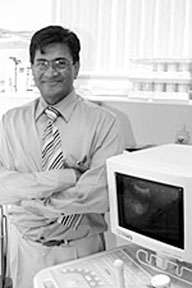Lankan doctor hailed for medical breakthrough
by A. C. de Silva
|

Dr. Sarath De Alwis Seneviratne
|
Remember former Thomian cricketer Dr. Sarath De Alwis Seneviratne?
Well he seems to be going places in the medical field, caring for the
sick. But before he took to the medical field, Sarath Seneviratne was a
fine cricketer and played for S. Thomas' Mount Lavinia from 1961 to
1965, captaining the team in 1965.
He scored 96 and 97 in the Royal-Thomian cricket encounters before
going to the University and playing in the Saravanamuttu Trophy Cricket
Tournament and he also played for the CCA in the Gopalan Trophy
encounter when the team was captained by Stanley Jayasinghe and in the
game Seneviratne made 50.
But his achievements on the medical field surpass his deeds on the
cricket field.
Dr. Seneviratne is a Consultant/Specialist in Obstetrics and
Gynaecology attached to Chrissie Tomlinson Memorial Hospital, has been
using the innovative Laparoscopic entry technique in Cayman for more
than two decades.
Now, doctors at Harvard Medical School are using this method and an
article on the technique, called the "modified Alwis Method", has
appeared in the latest edition of the medical journal Reviews in
Obstetrics and Gynaecology.
According to medical experts, one of the greatest advances in
medicine this century has been the advent of Laparoscopic Surgery, which
is a non-invasive way of entering the abdomen through a very small
incision to view the internal organs, through the use of "scope", called
a laparoscope. This type of surgery is also known as "keyhole" surgery
and is used for conditions such as ovarian cysts, fibroids,
endometriosis, ectopic pregnancies, hernia, certain cancers, gall
bladder, appendicitis, etc.
The entry of the scope, through the bellybottom, however accounts for
40-50 percent complications arising out of the procedure.
Minimising injury
"We developed a technique to minimise that type of injury," Dr.
Seneviratne said. "We showed it to Harvard medical professors, they
accepted it and have published it in their journal under "Modified De
Alwis - Seneviratne Method."
I've been using this technique for decades. I started this a long
time ago because of the fear of bowel injury," Dr. Seneviratne
explained.
Using the method, Dr. Seneviratne said that he had removed 47
fibroids from the uterus of one patient and 41 fibroids from the uterus
of another in October last year.He performed his first laparasopy in
Cayman Island in 1995 and has worked with Chrissie Tomlinson Memorial
Hospital since 1996.
His method relies as much on his ears as on his surgical skill
because he is guided by the sound of negative pressure being made in the
abdomen of the patient to determine exactly where to insert his surgical
instruments.
Dr. Seneviratne explained the method in layman's terms in his office
surrounded by members of the team he said were instrumental in the
success of the procedure.
Surface tension
"It is a simple technique. If you stand on your head, the bowels
don't drop because of surface tension that holds things together," he
said, licking his finger and touching a piece of paper which he then
lifts off the table, attached to his finger. "That's surface tension,"
he explained.
"The bowels do the same thing. They hold on to each other because of
surface tension. In the abdominal cavity, that surface prevents bowels
from dropping and changing position. Using that principle, we put a
little gas in and test to hear the response to that negative pressure
inside the abdomen.
"With that technique, we are able to say that we are definitely in
the abdominal correct place or not, so we don't have to put trocars in
the wrong place," he said.
Trocars are metal tubes that are inserted in the abdominal cavity
during laparascopic surgery.
Negative pressure
"It is similar to the mouth. If one sucks in the lips, when you let
them go you hear a noise. That's the movement from high pressure to low
pressure," he said.
Being able to listen to and identify the exact noise made in the
abdomen during his surgery, Dr. Seneviratne says it has enabled him to
carry out about 10,000 of the procedures. The modified version entails a
surgeon using monitors and machinery to detect the negative pressure,
rather than relying merely on the sound.
Guiding principle
When asked what his guiding principle in medicine is and whether he
is happy in his profession, Dr. Seneviratne replied, "My utmost priority
is giving comfort and relief to my patients. I feel a sense of
fulfilment whenever I am able to let patients get on in life with
dignity. It is also very rewarding being able to treat infertility.
Nothing in the world can replace the joy of bringing a baby out in to
the world."
Dr. Seneviratne specialises in treating infertility cases and about
60 to 70 percent of his patients comprise this segment. His most recent
accomplishment was when he was able to let a 46-year-old woman conceive
(without the need for an 'in vitro fertilisation' method - IVF) and give
birth to a healthy baby, after 28 years of trying.
The case of the patient is special because she was a diabetic and on
insulin medication.
He went on to say that IVF is good, but only when all other avenues
have been exhausted.
Key to success
When asked what makes him successful in his profession, he said: "I
am extremely careful and meticulous when operating or treating my
patients. I always think that the person I am dealing with or the person
lying on the operating table is my mother or wife. It always works for
me."
He says that he owes his success in life to the encouragement given
to him by his parents, his wife Rushantha and son Sacha.
Dr. Seneviratne also held out a `Big Thank You' to the staff of
Chrissie Tomlinson Memorial Hospital who have all made his job easier
and gives the utmost support all the time. |

